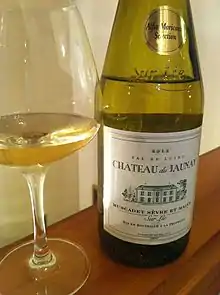Lees (fermentation)
Lees are deposits of dead yeast or residual yeast and other particles that precipitate, or are carried by the action of "fining", to the bottom of a vat of wine after fermentation and aging. The same while brewing beer at a brewery is known as trub – the same from secondary fermentation of wine and beer are the lees or equally, as to beer only, dregs. This material is the source for most commercial tartaric acid, which is used in cooking and in organic chemistry.[1]

Normally, the wine is transferred to another container (racking), leaving this sediment behind. Some wines (notably Chardonnay, Champagne, and Muscadet) are sometimes aged for a time on the lees (a process known as sur lie), leading to a distinctive yeasty aroma and taste. The lees may be stirred (French: bâtonage) for uptake of their flavour.
The lees are an important component in the making of ripasso, where the leftover lees from Amarone are used to impart more flavour and colour to partially aged Valpolicella.
Sur lie

Sur lie literally translates from French as 'on lees'. Sur lie wines are bottled directly from the lees without racking (a process for filtering the wine). In the case of great Chardonnay, such as Montrachet, this adds a toasty, nutty "hazelnut" quality and additional depth and complexity. Chemically, this can alter the oak flavour molecules, increasing the integration, and making the oak seem less obtrusive to the palate. This is desirable because oak tannins are polyphenolic acids, and can be harsh. This process can also give an added freshness and creaminess to the wine, and improve color and clarity. Muscadet is made in this fashion. The effect of the lees during bottle fermentation for at least 18 months on Champagne is considerable. The "bready" toasty notes associated with some of the greatest sparkling wines made are the result of sur lie aging.[2]
Other uses
Beer on an element of lees (residual sediment) is also sold, such as many
- Trappist beers
- Unibroue Quebec, Canada-based ales/beers
- Real ales of older styles (not India Pale Ale)
Kombucha can also be brewed sur lie.
Light lees protocol
In a process in which yeast is added to wine that has completed primary fermentation, this secondary yeast addition typically remains in the wine from 2–8 weeks, depending on the winemaker's goals. The yeast is stirred (bâtonage) frequently, and racked when the protocol is complete. Also known as secondary autolysis, a light lees protocol releases additional mannoproteins and polysaccharides that can influence the flavour, tannins, and acidity of the wine.
References
- J.-M. Kassaian "Tartaric acid" in Ullmann's Encyclopedia of Industrial Chemistry; VCH: Weinheim, Germany, 2002, 35, 671-678. doi:10.1002/14356007.a26_163
- J. Robinson (ed) "The Oxford Companion to Wine" Third Edition pg 669 Oxford University Press 2006 ISBN 0198609906